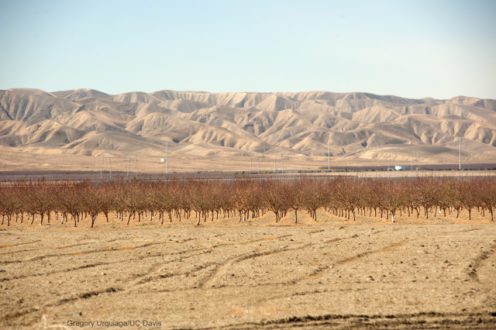Jul 15, 2021One-quarter of California’s irrigated farmland get a 95% cut in water supply
With depleted reservoirs and limited water supplies across California, Gov. Gavin Newsom recently expanded the drought emergency order to nine additional counties and signed an executive order calling on all Californians to voluntarily reduce water use by 15%.
The action by the governor follows drought disaster orders issued in April and May, and brings a total of 50 of the state’s 58 counties under the drought state of emergency. Nine counties added to the drought declaration include: Inyo, Marin, Mono, Monterey, San Luis Obispo, San Mateo, Santa Barbara, Santa Clara and Santa Cruz.
Brent Burchett, executive director of the San Luis Obispo County Farm Bureau, said, “In our county, we weren’t waiting for the governor’s declaration to make local changes.
“SGMA (Sustainable Groundwater Management Act) is the more acute regulation that we’re mindful of regarding cutbacks coming to agriculture,” Burchett said. “We’re already prepared for that, but this current drought is just another reminder of how bad things can be and how quickly they can change.”
The declaration also directs state agencies to take further actions to address drought impacts. Following the earlier drought declarations, state regulators imposed emergency regulations and sent notices of water unavailability to farmers who are trying to negotiate their crops through another drought year, in part with groundwater, California’s backup supply in drier years. Under groundwater plans now in place throughout the San Joaquin Valley, however, historic pumping levels must be significantly ramped down.
Drought declarations issued this spring led to water curtailments for Russian River watershed counties of Mendocino and Sonoma, the Sacramento-San Joaquin Delta watershed and are currently being considered for the Scott and Shasta rivers.
“There are no silver-bullet opportunities to just ‘use less water’ without sacrificing productivity and the livelihoods of people in farm communities,” Jamie Johansson, president of the California Farm Bureau, said. “While demand for water can be reduced, one thing will not change and that is the public’s demand for food.”
The new proclamation calls on urban, municipal, industrial and agricultural water users and purveyors throughout the state to voluntarily reduce water use by 15%. But a map from the California Farm Water Coalition showing water cutbacks indicates agricultural regions throughout the state have already far exceeded this level in the form of reduced allocations, water rights curtailments and proposed or existing emergency regulations.
Johansson noted that one-quarter of the state’s irrigated farmland has already seen a 95% reduction in its expected water supplies, and more than half of that farmland is getting no surface water at all.
Norm Groot, executive director of the Monterey County Farm Bureau, said the primary concern at this point is 2022.
“If we don’t have precipitation this winter, our reservoirs will not have sufficient water supplies to continue releases for consistent recharge in 2022,” Groot said. “We are conscripted to release water throughout the year due to NOAA Fisheries requirements for habitat and fish passage, which helps with groundwater recharge but doesn’t allow us to manage our water storage for long-term efficiency.”
Farmers in San Luis Obispo County also are worried about another drought next year, Burchett said.
“That’s when reservoir levels will start dropping to that 10-15% level that gets scary for drinking-water purposes, not just agriculture,” he said.
Having to do more with less is a way of life for most farmers, said Monterey County vegetable grower Colby Pereira, who serves as president of the Monterey County Farm Bureau.
“Farmers have and will continue to utilize best management practices with water usage in mind,” she said, adding that farmers are by nature resourceful with not only water but all inputs.
California farmers and ranchers have always demonstrated a willingness to find better ways to conserve natural resources, including water, Johansson said, adding that they have invested billions of dollars in more water-efficient technology and infrastructure, including drip and microsprinklers, soil-moisture monitoring, computerized irrigation controls and remote sensing.
“As Gov. Newsom has pointed out, California can’t just ‘tighten its belt’ periodically in response to drought and hope to survive years like this,” Johansson said. “Rather, life must be breathed into the storage and infrastructure projects that we have been discussing for years, such as construction of Sites Reservoir, the Friant-Kern Canal fix and more.
“This is another opportunity to streamline and take action on projects that alleviate future droughts,” he added.
State officials estimate that an additional 15% voluntary reduction from 2020 levels could save as much as 850,000 acre-feet of water over the next year for future use, or enough to supply more than 1.7 million households..
– Christine Souza, California Farm Bureau















